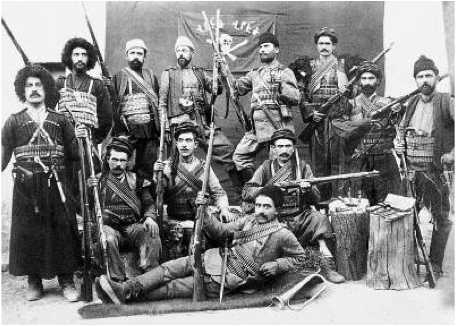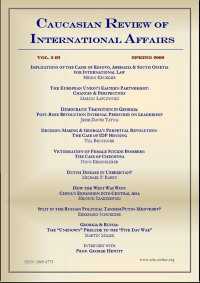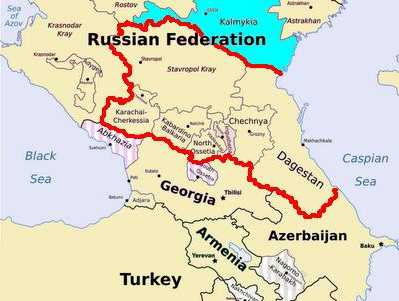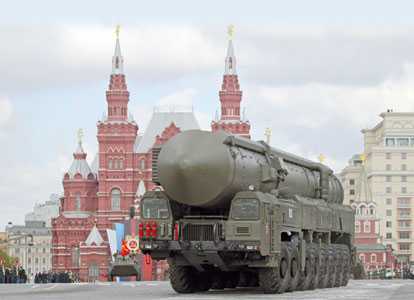by Rick Rozoff

Global Research, September 16, 2009
Tensions are mounting in the Black Sea with the threat of another conflict between U.S. and NATO client state Georgia and Russia as Washington is manifesting plans for possible military strikes against Iran in both word and deed.
Referring to Georgia having recently impounded several vessels off the Black Sea coast of Abkhazia, reportedly 23 in total this year, the New York Times wrote on September 9 that “Rising tensions between Russia and Georgia over shipping rights to a breakaway Georgian region have opened a potential new theater for conflict between the countries, a little more than a year after they went to war.” [1]
Abkhazian President Sergei Bagapsh ordered his nation’s navy to respond to Georgia’s forceful seizure of civilian ships in neutral waters, calling such actions what they are – piracy – by confronting and if need be sinking Georgian navy and coast guard vessels. The Georgian and navy and coast guard are trained by the United States and NATO.
The spokesman of the Russian Foreign Ministry addressed the dangers inherent in Georgia’s latest provocations by warning “They risk aggravating the military and political situation in the region and could result in serious armed incidents.” [2]
On September 15 Russia announced that its “border guards will detain all vessels that violate Abkhazia’s maritime border….” [3]
Russia would be not only entitled but obligated to provide such assistance to neighboring Abkhazia as “Under mutual assistance treaties signed last November, Russia pledged to help Abkhazia and South Ossetia protect their borders, and the signatories granted each other the right to set up military bases in their respective territories.” [4]
In attempting to enforce a naval blockade – the International Criminal Court plans to include blockades against coasts and ports in its list of acts of war this year [5] – against Abkhazia, the current Georgian regime of Mikheil Saakashvili is fully aware that Russia is compelled by treaty and national interests alike to respond. Having been roundly defeated in its last skirmish with Russia, the five-day war in August of last year, Tbilisi would never risk actions like its current ones without a guarantee of backing from the U.S. and NATO.
Days after last year’s war ended then U.S. Senator and now Vice President Joseph Biden flew into the Georgian capital to pledge $1 billion in assistance to the nation, making Georgia the third largest recipient of American foreign aid after Egypt and Israel.
U.S. and NATO warships poured into the Black Sea in August of 2008 and American ships visited the Georgia port cities of Batumi and Poti to deliver what Washington described as civilian aid but which Russian sources suspected contained replacements for military equipment lost in the conflict.
Less than a month after the war ended NATO sent a delegation to Georgia to “evaluate damage to military infrastructure following a five-day war between Moscow and Tbilisi….” [6]
In December a meeting of NATO foreign ministers agreed upon a special Annual National Program for Georgia and in the same month Washington announced the creation of the United States-Georgia Charter on Strategic Partnership.
In the past week a top-level delegation of NATO defense and logistics experts visited Georgia on September 9 “to promote the development of the Georgian Armed Forces” [7] and on September 14 high-ranking officials of the U.S. George C. Marshall European Center for Security Studies arrived at the headquarters of the Georgian Ministry of Defense “to review issues of interdepartmental coordination in the course of security sector management and national security revision.” [8]
The ongoing military integration of Georgia and neighboring Azerbaijan, which also borders Iran – Washington’s Georgetown University is holding a conference on Strategic Partnership between U.S. and Azerbaijan: Bilateral and Regional Criteria on September 18 – by the Pentagon and NATO is integrally connected with general military plans in the Black Sea and the Caucasus regions as a whole and, even more ominously, with joint war plans against Iran.
As early as January of 2007 reports on that score surfaced in Bulgarian and Romanian news sources. Novinite (Sofia News Agency) reported that the Pentagon “could be using its two air force bases in Bulgaria and one on Romania’s Black Sea coast to launch an attack on Iran….” [9]
The bases are the Bezmer and Graf Ignitievo airbases in Bulgaria and the Mihail Kogalniceanu counterpart near the Romanian city of Constanza on the Black Sea.
The Pentagon has seven new bases altogether in Bulgaria and Romania and in addition to stationing warplanes – F-15s, F-16s and A-10 Thunderbolts – has 3,000-5,000 troops deployed in the two nations at any given time, and Washington established its Joint Task Force-East (JTF-East) permanent headquarters at the Mihail Kogalniceanu airbase in Romania.
A U.S. government website provides these details about Joint Task Force-East:
“All U.S. Army and U.S. Air Force training operations in Romania and Bulgaria will fall under the command of JTF–East, which in turn is under the command of USEUCOM [United States European Command]. Physically located in Romania and Bulgaria, JTF East will include a small permanent headquarters (in Romania) consisting of approximately 100-300 personnel who will oversee rotations of U.S. Army brigade-sized units and U.S. Air Force Weapons Training Deployments (WTD). Access to Romanian and Bulgarian air and ground training facilities will provide JTF-East forces the opportunity to train and interact with military forces throughout the entire 92-country USEUCOM area of responsibility. U.S. Army Europe (USAREUR) and U.S Air Forces in Europe (USAFE) are actively involved in establishing JTF-East.” [10]
The four military bases in Romania and three in Bulgaria that the Pentagon and NATO have gained indefinite access to since the two nations were incorporated into the North Atlantic Treaty Organization in 2004 allow for full spectrum operations: Infantry deployments in the area and downrange to Afghanistan and Iraq, runways for bombers and fighter jets, docking facilities for American and NATO warships including Aegis class interceptor missile vessels, training grounds for Western special forces and for foreign armed forces being integrated into NATO.
Added to bases and troops provided by Turkey and Georgia – and in the future Ukraine – the Bulgarian and Romanian sites are an integral component of plans by the U.S. and its allies to transform the Black Sea into NATO territory with only the Russian coastline not controlled by the Alliance. And that of newly independent Abkhazia, which makes control of that country so vital.
Last week the Romanian defense ministry announced the intention to acquire between 48 and 54 new generation fighter jets – American F-16s and F-35s have been mentioned – as part of “a new strategy for buying multi-role aircraft, which means to first buy aircraft to make the transition to fifth generation equipment, over the coming 10-12 years.” [11]
With the recent change in government in the former Soviet republic of Moldova – the aftermath of this April’s violent “Twitter Revolution” – the new parliamentary speaker, Mihai Ghimpu, has openly spoken of the nation merging with, which is to say being absorbed by, neighboring Romania. Transdniester [the Pridnestrovian Moldovan Republic] broke away from Moldova in 1990 exactly because of the threat of being pulled into Romania and fighting ensued which cost the lives of some 1,500 persons.
Romania is now a member of NATO and should civil war erupt in Moldova and/or fighting flare up between Moldova and Transdniester and Romania sends troops – all but a certainty – NATO can activate its Article 5 military clause to intervene. There are 1,200 Russian peacekeepers in Transdniester.
Transdniester’s neighbor to its east is Ukraine, linked with Moldova through the U.S.-concocted GUAM (Georgia, Ukraine, Azerbaijan, Moldova) bloc, which has been collaborating in enforcing a land blockade against Transdniester. Ukraine’s President Viktor Yushchenko, whose poll ratings are currently in the low single digits, is hellbent on dragging his nation into NATO against overwhelming domestic opposition and can be counted on to attack Transdniester from the eastern end if a conflict breaks out.
A Moldovan news source last week quoted an opposition leader issuing this dire warning:
“Moldova’s ethnic minorities are categorically against unification with Romania.
“If we, those who are not ethnic Moldovans, will have to defend Moldova’s
statehood, then we will find powerful allies outside Moldova, including in Russia. Along with it, Ukraine, Turkey and Bulgaria would be involved in this fighting. Last year we all witnessed how Russia defended the interests of its nationals in South Ossetia and Abkhazia. Why does somebody believe that in case of a civil war in Moldova Russia will simply watch how its nationals are dying? Our task is to prevent such developments.” [12]
Indeed, the entire Black Sea and Caucasus regions could go up in flames if Western proxies in GUAM attack any of the so-called frozen conflict nations – Abkhazia and South Ossetia by Georgia, Nagorno Karabakh by Azerbaijan and Transdniester by Moldova and Ukraine. A likely possibility is that all four would be attacked simultaneously and in unison.
An opportunity for that happening would be a concentrated attack on Iran, which borders Azerbaijan and Armenia. The latter, being the protector of Nagorno Karabakh, would immediately become a belligerent if Azerbaijan began military hostilities against Karabakh.
On September 15 news stories revealed that the Bipartisan Policy Center in Washington, DC, founded in 2007 by former Senate Majority Leaders Howard Baker, Tom Daschle, Bob Dole and George Mitchell, had released a report which in part stated, “If biting sanctions do not persuade the Islamic Republic to demonstrate sincerity in negotiations and give up its enrichment activities, the White House will have to begin serious consideration of the option of a U.S.-led military strike against Iranian nuclear facilities.” [13]
The report was authored by Charles Robb, a former Democratic senator from
Virginia, Daniel Coats, former Republican senator from Indiana, and retired General Charles Wald, a former deputy commander of the U.S. European Command.
Iran is to be given 60 days to in essence abandon its civilian nuclear power program and if it doesn’t capitulate the Obama administration should “prepare overtly for any military option” which would include “deploying an additional aircraft carrier battle group to the waters off Iran and conducting joint exercises with U.S. allies.” [14]
The main Iranian nuclear reactor is being constructed at Bushehr and would be a main target of any U.S. and Israeli bombing and missile attacks. As of 2006 there were 3,700 Russian experts and technicians – and their families – living in the environs of the facility.
It has been assumed for the past eight years that a military attack on Iran would be launched by the United States from aircraft carriers in the Persian Gulf and by long-range Israeli bombers flying over Iraq and Turkey.
During that period the U.S. and its NATO allies have also acquired access to airbases in Iraq, Afghanistan, Pakistan (in Baluchistan, bordering Iran), Kyrgyzstan and Tajikistan in addition to those they already have in Turkey.
Washington and Brussels have also expanded their military presence into Bulgaria, Georgia and Romania on the Black Sea and into Azerbaijan on the Caspian Sea bordering northeastern Iran.
Plans for massive military aggression against Iran, then, might include air and missile strikes from locations much nearer the nation than previously suspected.
The American Defense Security Cooperation Agency announced plans last week to supply Turkey, the only NATO member state bordering Iran, with almost $8 billion dollars worth of theater interceptor missiles, of the upgraded and longer-range PAC-3 (Patriot Advance Capability-3) model. The project includes delivering almost 300 Patriots for deployment at twelve command posts inside Turkey.
In June the Turkish government confirmed that NATO AWACS (Airborne Warning and Control System) planes would be deployed in its Konya province.
The last time AWACS and Patriot missiles were sent to Turkey was in late 2002 and early 2003 in preparation for the invasion of Iraq.
On September 15 the newspaper of the U.S. armed forces, Stars and Stripes, ran an article titled “U.S., Israeli forces to test missile defense while Iran simmers,” which included these details on the biannual Juniper Cobra war games:
“Some 1,000 U.S. European Command troops will soon deploy to Israel for a large-scale missile defense exercise with Israeli forces.
“This year’s Juniper Cobra comes at a time of continued concern about Iran’s nuclear program, which will be the subject of talks in October.
“The U.S. troops, from all four branches of service, will work alongside an equal number of Israel Defense Force personnel, taking part in computer-simulated war games….Juniper Cobra will test a variety of air and missile defense technology during next month’s exercise, including the U.S.-controlled X-Band.” [15]
The same feature documented that this month’s exercise is the culmination of months of buildup.
“In April, about 100 Europe-based personnel took part in a missile defense exercise that for the first time incorporated a U.S.-owned radar system, which was deployed to the country in October 2008. The U.S. X-Band radar is intended to give Israel early warning in the event of a missile launch from Iran.
“For nearly a year, a mix of troops and U.S. Defense Department contractors have been managing the day-to-day operation of the X-Band, which is situated at Nevatim air base in the Negev Desert.” [16]
The same publication revealed two days earlier that the Pentagon conducted a large-scale counterinsurgency exercise with the 173rd Airborne Brigade and the 12th Combat Aviation Brigade last week in Germany, “the largest such exercise ever held by the U.S. military outside of the United States….” [17] The two units are scheduled for deployment to Afghanistan and Iraq, respectively, but could be diverted to Iran, which has borders with both nations, should need arise.
What the role of Black Sea NATO states and clients could be in a multinational, multi-vectored assault on Iran was indicated in the aftermath of last year’s Georgian-Russian war.
At a news conference at NATO headquarters in Brussels a year ago, Russian ambassador to NATO Dmitry Rogozin “said that Russian intelligence had obtained information indicating that the Georgian military infrastructure could be used for logistical support of U.S. troops if they launched an attack on Iran.” [18]
Rogozin was further quoted as saying, “What NATO is doing now in Georgia is restoring its ability to monitor its airspace, in other words restoring the whole locator system and an anti-missile defence system which were destroyed by Russian artillery.
“[The restoration of surveillance systems and airbases in Georgia is being] done for logistic support of some air operations either of the Alliance as a whole or of the United States in particular in this region. The swift reconstruction of the airfields and all the systems proves that some air operation is being planned against another country which is located not far from Georgia….” [19]
Early last October Nikolai Patrushev, Secretary of the Russian Security
Council “described the U.S. and NATO policy of increasing their military presence in Eastern Europe as seeking strategic military superiority over Russia.
“The official added that the United States would need allies in the region if the country decided to attack Iran.” [20]
Patrushev stated, “If it decides to carry out missile and bomb attacks
against Iran, the US will need loyal allies. And if Georgia is involved in this war, this will pose additional threats to Russia’s national security.” [21]
Later last October an Azerbaijani website reported that 100 Iranian Air Force jets were exercising near the nation’s border and that “military sources from the United States reported that territories in Azerbaijan and in Georgia may be used for attacking Iran….” [22]
Writing in The Hindu the same month Indian journalist Atul Aneja wrote of the effects of the Georgian-Russian war of the preceding August and offered this information:
“Russia’s military assertion in Georgia and a show of strength in parts of West Asia [Middle East], combined with domestic political and economic preoccupations in Washington, appear to have forestalled the chances of an immediate strike against Iran.
“Following Russia’s movement into South Ossetia and Abkhazia, Russian President Dmitry Medvedev acknowledged that Moscow was aware that serious plans to attack Iran had been laid out. ‘We know that certain players are planning an attack against Iran. But we oppose any unilateral step and [a] military solution to the nuclear crisis.’
“Russia seized control of two airfields in Georgia from where air strikes against Iran were being planned. The Russian forces also apparently recovered weapons and Israeli spy drones that would have been useful for the surveillance of possible Iranian targets.” [23]
The same newspaper, in quoting Dmitry Rogozin asserting that Russian military intelligence had captured documents proving Washington had launched “active military preparations on Georgia’s territory” for air strikes against Iran, added information on Israeli involvement:
“Israel had supplied Georgia with sophisticated Hermes 450 UAV spy drones, multiple rocket launchers and other military equipment that Georgia, as well as modernised Georgia’s Soviet-made tanks that were used in the attack against South Ossetia. Israeli instructors had also helped train Georgia troops.” [24]
Rather than viewing the wars of the past decade – against Yugoslavia, Afghanistan and Iraq – and the concomitant expansion of U.S. and NATO military presence inside all three countries and in several others on their peripheries as an unrelated series of events, the trend must be seen for what it is: A consistent and calculated strategy of employing each successive war zone as a launching pad for new aggression.
The Pentagon has major military bases in Kosovo, in Afghanistan and in Iraq that it never intends to abandon. The U.S. and its NATO allies have bases in Bulgaria, Romania, Kyrgyzstan, Tajikistan, Uzbekistan, Kuwait, Bahrain (where the U.S. Navy’s 5th Fleet is headquartered) and other nations in the vicinity of the last ten years’ wars which can be used for the next ten – or twenty or thirty – years’ conflicts.
1) New York Times, September 9, 2009
2) Ibid
3) Russian Information Agency Novosti, September 15, 2009
4) Ibid
5) Wikipedia
6) Agence France-Presse, September 8, 2009
7) Trend News Agency, September 9, 2009
8) Georgia Ministry of Defence, September 14, 2009
9) Turkish Daily News, January 30, 2007
10) U.S. Department of State
11) The Financiarul, September 9, 2009
12) Infotag, September 11, 2009
13) Bloomberg News, September 15, 2009
14) Ibid
15) Stars and Stripes, September 15, 2009
16) Ibid
17) Stars and Stripes, September 13, 2009
18) Russian Information Agency Novosti, September 17, 2008
19) Russia Today, September 17, 2008
20) Russian Information Agency Novosti, October 1, 2008
21) Fars News Agency, October 2, 2008
22) Today.AZ, October 20, 2008
23) The Hindu, October 13, 2008
24) The Hindu, September 19, 2008
https://www.globalresearch.ca/black-sea-crisis-deepens-as-us-nato-threat-to-iran-grows/15239
 Great Britain will not recognize the ‘Armenian genocide’ in the near future.
Great Britain will not recognize the ‘Armenian genocide’ in the near future.





